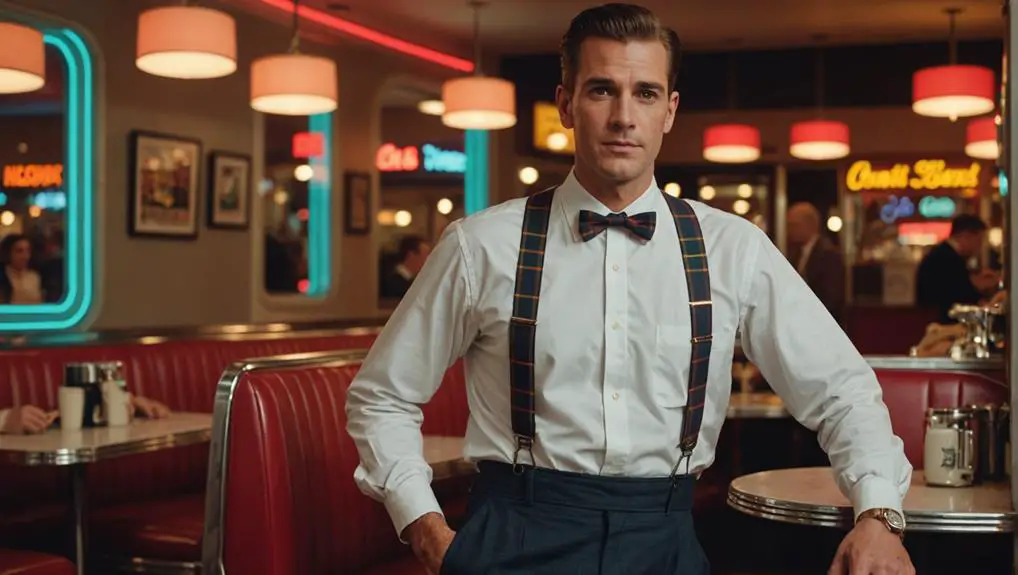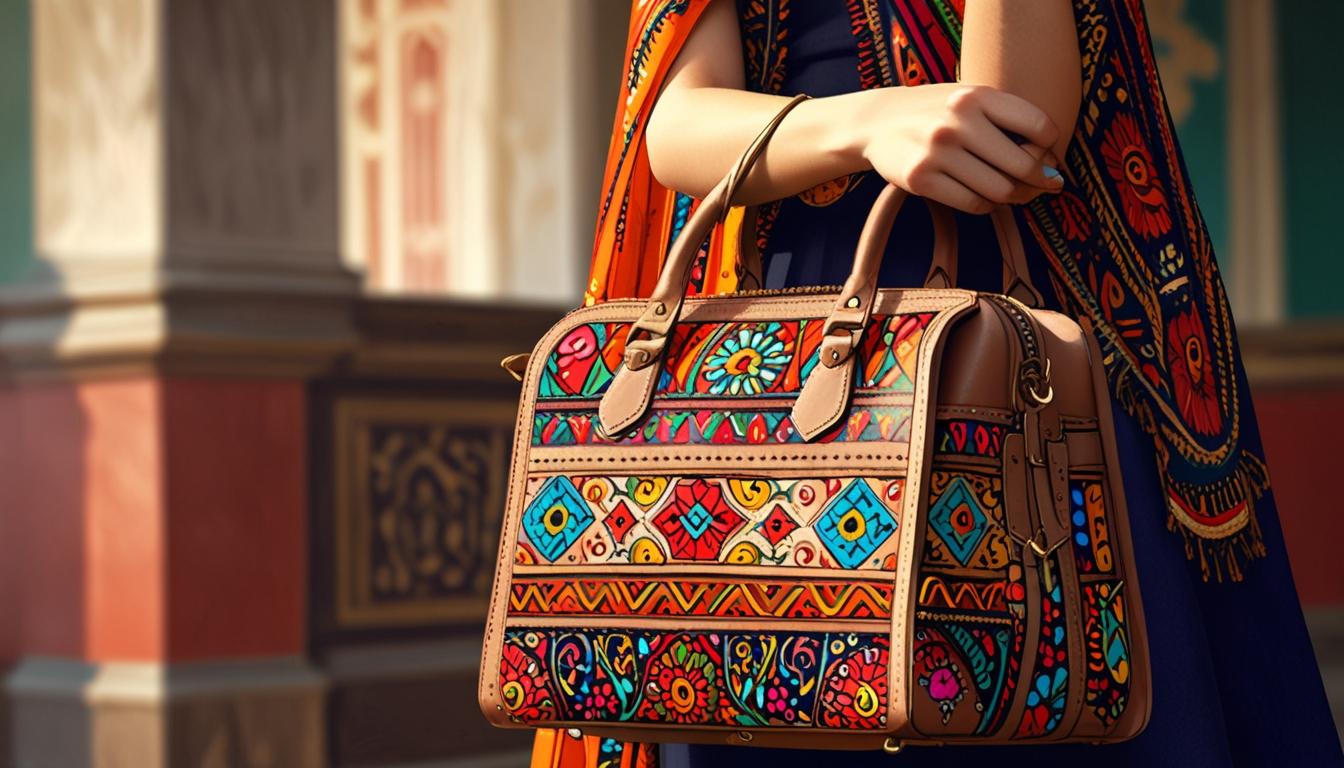In the 1950s, men's suspenders evolved into more than just practical garments; they became crucial style statements. As post-war prosperity surged, you'd find stylish suspenders complimenting both tailored suits and casual wear. Icons like Marlon Brando and James Dean showcased them as symbols of rugged sophistication. With designs ranging from colorful silk to classic Y-Back styles, suspenders catered to personal expression. Enhanced materials, including elastic and synthetic fibers, improved comfort while maintaining functionality. This decade cemented suspenders as essential accessories in men's fashion, embodying a blend of practicality and flair that continues to influence today's trends. Discover more about this stylish evolution.
Historical Overview of Suspenders
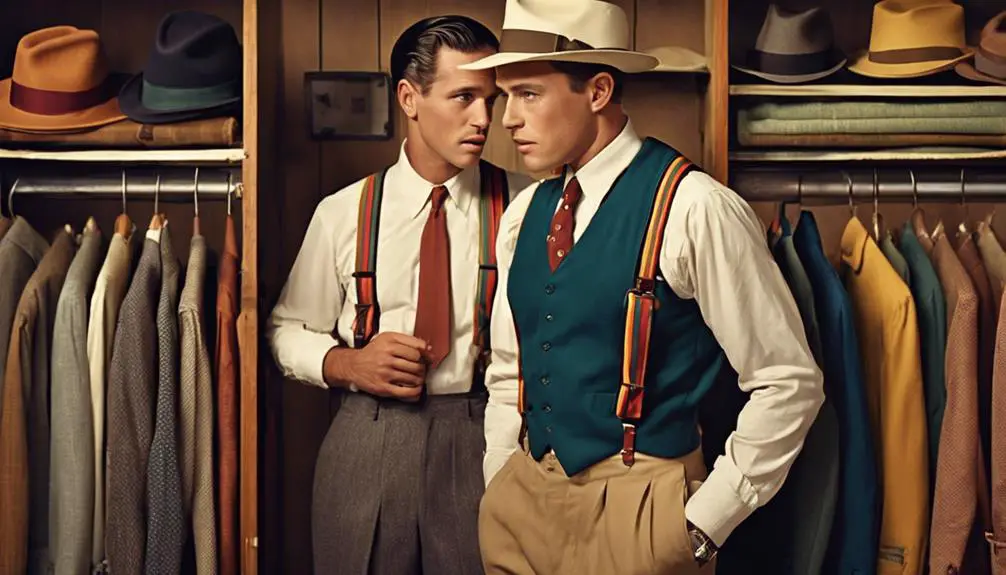
Suspenders, also known as braces, have a rich history that reflects changing fashion sensibilities and societal norms. In the 1820s, Albert Thurston revolutionized men's suspenders with his introduction of the H-Back design and leather loops, setting a foundation for future styles. This innovation not only enhanced their aesthetic appeal but also contributed to their practical use in holding up trousers. Vintage clothing labels often provide insights into the era of suspenders, highlighting vintage clothing characteristics that can aid in identification.
The introduction of metal clasps in 1894 marked another significant turning point, allowing suspenders to clip onto pants without the need for waist buttons. This development made them more accessible and user-friendly, solidifying their place in men's vintage fashion. However, during the early 20th century, as lower-sitting pants gained favor, suspenders saw a decline in popularity despite their recognized posture-supporting benefits.
The 1950s brought a resurgence in men's suspenders, as they re-emerged in tailored suits, driven by post-war prosperity and shifting style preferences. Hollywood icons like Marlon Brando and James Dean helped elevate suspenders to casual attire, seamlessly integrating them into everyday fashion. This blend of practicality and style established suspenders as a versatile accessory, embodying both tradition and modernity.
1950s Fashion Trends
The 1950s marked a vibrant evolution in men's fashion, characterized by a blend of casual comfort and tailored sophistication. Suspenders emerged as a key accessory, transcending their traditional origins to become a staple for both formal and informal outfits. You might notice how Hollywood icons like Marlon Brando and James Dean popularized this trend, expertly pairing jeans with belt loops while still incorporating suspenders for that polished look.
Made primarily from elastic, these mens suspenders came in various styles, including practical clip-on designs that made them accessible for everyday wear. As post-war prosperity flourished, men sought ways to express their individuality and sophistication, often teaming suspenders with crisp dress shirts. This decade also introduced colorful and patterned options, reflecting a growing interest in personal expression through fashion.
The shift towards more relaxed styles didn't diminish the appeal of suspenders; instead, it enhanced their versatility, allowing you to elevate your outfits effortlessly. With their ability to complement tailored suits and casual ensembles alike, suspenders became an essential component of 1950s menswear, blending functionality with style in a way that still resonates today.
Cultural Impact on Style
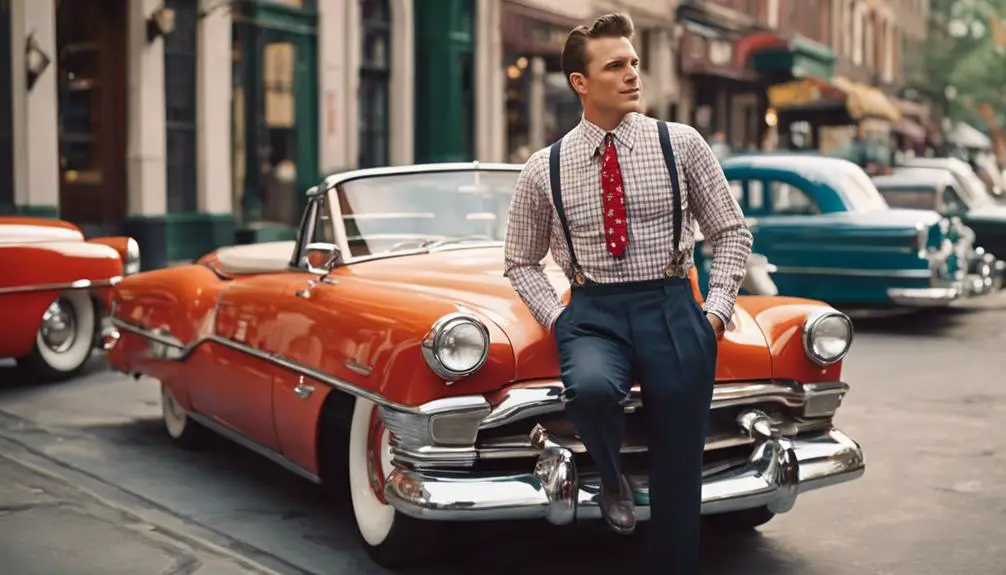
Fashion in the 1950s was not just about clothing; it reflected broader cultural shifts that shaped American identity. Suspenders emerged as a key fashion statement, evolving from mere practicality to a symbol of style and class. Worn by Hollywood icons like Marlon Brando and James Dean, they complemented tailored suits and casual denim alike, showcasing a blend of ruggedness and sophistication that resonated with the post-war generation.
As television gained prominence, shows like "The Honeymooners" featured characters donning suspenders, further embedding them into the fabric of American culture. This visibility allowed suspenders to transcend their utilitarian roots, becoming a staple in men's wardrobes.
The post-war economic boom fueled a desire for fashion that exuded confidence and individuality. Suspenders, especially in brown leather, became synonymous with a new masculine identity that embraced both formality and rebellion. Youth subcultures adopted them as a countercultural element, highlighting the decade's diverse style landscape. Within this framework, suspenders weren't just accessories; they were powerful fashion statements that mirrored the evolving dynamics of society, making them a quintessential element of 1950s men's fashion.
Popular Styles and Designs
Transforming men's fashion in the 1950s, suspenders became a pivotal accessory that showcased a range of styles and designs. You'd find suspenders not just functional, but also a bold fashion statement that complemented tailored suits and formal attire. The decade brought various styles, with the Y-Back and H-Back designs becoming particularly popular.
Here are four standout features of suspenders in the 1950s:
- Y Shape: The Y-Back design offered a sleek silhouette, making it a favorite for both casual and formal looks.
- Silk Material: Luxurious silk suspenders emerged, showcasing intricate patterns and vibrant colors that matched the era's bold fashion trends.
- Durability: Made from durable elastic and silk, these accessories combined style with practicality, ensuring they held up through daily wear.
- Metal Clips: The integration of metal clips made attaching suspenders to pants effortless, enhancing their appeal as a stylish yet functional choice.
As you explore this era's fashion, it's clear that suspenders were more than just a necessity; they were an essential part of a well-rounded wardrobe.
Notable Figures Wearing Suspenders
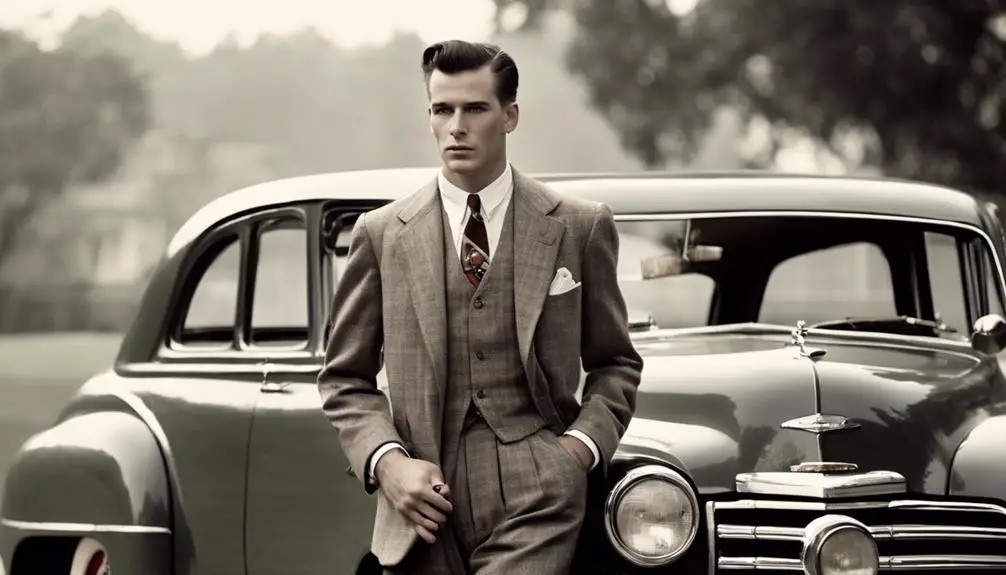
Suspenders found their way into the wardrobes of many notable figures during the 1950s, illustrating their reach beyond mere functionality. Hollywood icons like Marlon Brando and James Dean redefined casual fashion by pairing suspenders with jeans and t-shirts, giving the garment a vintage appeal that resonated with youth culture. Their effortless style made suspenders synonymous with rebellion and coolness, showcasing how a simple accessory could elevate an outfit.
In the business world, suspenders became a symbol of sophistication, adorned by bankers and stockbrokers who wore them with tailored suits, often secured with polished metal buttons. This trend mirrored the post-war prosperity, where appearances mattered greatly.
Television personalities, such as comedian Bob Hope, further popularized suspenders on screen, embedding them into American culture. The character of Professor Henry Higgins in "My Fair Lady," played by Rex Harrison, exemplified their formal usage, proving that suspenders could bridge both casual and refined aesthetics.
Functional Uses in Daily Life
During the 1950s, men relied on suspenders not just for style but as a practical solution to everyday challenges. Solid suspenders were essential in keeping trousers securely in place, especially with the high-waisted fashion trend of the time. Their design evolved, with elastic varieties becoming popular for their comfort and functionality.
Here are four key functional uses of men's suspenders during this decade:
- Support for High-Waisted Styles: They guaranteed trousers stayed at the desired height, maintaining a polished look.
- Freedom of Movement: Unlike belts, suspenders allowed greater mobility, making them ideal for both office workers and those in manual labor.
- Versatile Fashion Accessory: Whether paired with a dress shirt or overalls, suspenders added a touch of style without compromising on practicality.
- Safety in Labor: For men in construction and logging, sturdy suspenders provided extra support, preventing trousers from sagging while working.
In this way, suspenders became more than just a fashion statement; they were integral to daily life, offering both style and function in a rapidly changing world.
Evolution of Materials and Fabrics
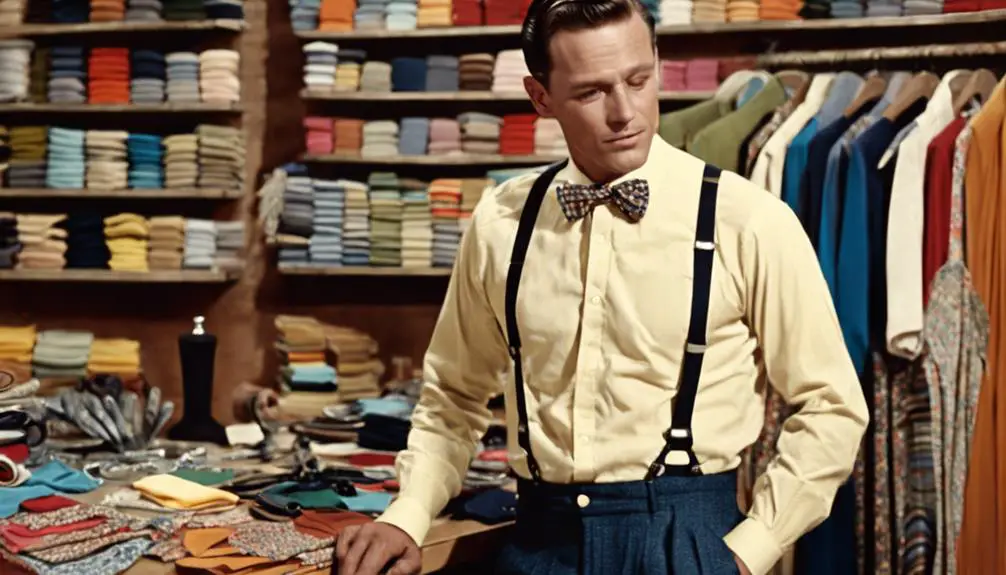
As men embraced the practicality of suspenders in their daily lives, the materials used to create them began to reflect the era's burgeoning sense of style and comfort. The 1950s marked a significant shift from traditional cotton to luxurious fabrics like silk, showcasing the post-war prosperity and evolving fashion sensibilities. These changes were accompanied by the introduction of synthetic fibers, which offered more durable and colorful options, enhancing both functionality and aesthetic appeal.
You might notice that many manufacturers incorporated elastic materials, allowing for improved comfort and adjustability. This made wearing suspenders not just practical but also user-friendly. Leather accents emerged as a popular choice, adding sophistication and quality to designs—especially for formal occasions where you wanted to make a statement.
Moreover, the decade saw a rise in patterned and textured fabrics, such as houndstooth and paisley, allowing you to express your individuality through your suspenders. With styles ranging from classic BUTTON suspenders to vibrant stripes, the evolution of materials and fabrics in the 1950s transformed suspenders into a fashionable accessory, blending utility with personal expression.
Shift in Men's Accessories
In the 1950s, a notable shift occurred in men's accessories, reflecting broader changes in societal norms and fashion sensibilities. Men's suspenders, once viewed as purely functional, became a symbol of style and sophistication, influenced heavily by icons like Marlon Brando and James Dean. This era marked a turning point where accessories like wedding braces transcended their utilitarian origins.
Here are some key aspects of this shift:
- Resurgence of Suspenders: Post-war prosperity led to tailored suits becoming more popular, with suspenders complementing these looks.
- Fashion Statement: Suspenders moved beyond their practical use, showcasing personal style—often worn with both formal and casual attire.
- Diverse Designs: The introduction of various materials, from silk to vibrant patterns, including Polka Dot designs, offered men more choices than ever.
- Cultural Influence: Hollywood stars helped cement the idea that suspenders could enhance one's overall fashion statement, making them a must-have accessory.
This evolution highlights how men's accessories adapted to changing tastes and how suspenders carved out a distinctive niche in the fashion landscape of the 1950s.
Legacy and Modern Revival

The legacy of men's suspenders from the 1950s continues to influence contemporary fashion, blending nostalgia with modern sensibilities. This decade marked a resurgence, as Hollywood stars popularized suspenders as essential to formal attire. While the adoption of belt loops in jeans led to a decline among younger men, older generations maintained a fondness for this vintage accessory.
Today, suspenders are experiencing a revival, appreciated by both fashion enthusiasts and those who cherish vintage styles. Their versatility allows them to complement casual and formal outfits alike, making them a staple for the style-savvy individual.
Here's a quick comparison of suspenders from the 1950s versus today:
| Aspect | 1950s Suspenders |
|---|---|
| Fashion Icon | Hollywood Stars |
| Common Usage | Formal Attire |
| Popularity | Older Generations |
| Decline Reasons | Belt Loops in Jeans |
| Modern Appeal | Vintage Enthusiasts |
As you explore your wardrobe, consider how incorporating suspenders can elevate your look, merging the elegance of the past with today's trends. This timeless accessory not only enhances style but also pays homage to its rich history.
Frequently Asked Questions
When Did Men Stop Using Suspenders?
Men started moving away from suspenders in the early 1900s, as lower-sitting pants gained popularity. By World War I, belts became practical, and Hollywood's influence in the 1950s solidified this shift, diminishing suspenders' mainstream appeal.
Why Did Men Wear Braces Instead of Belts?
You wear braces instead of belts to achieve a refined silhouette. Braces provide better support for high-waisted trousers, ensuring comfort and elegance while maintaining a polished appearance, which enhances your overall style effortlessly.
What Decade Did Men Wear Suspenders?
You'll find suspenders were worn mainly in the 1950s. This decade marked a stylish revival, where they shifted from basic functionality to fashionable statements, embraced by various subcultures for both casual and formal occasions.
What Styles for Men Were Especially Popular in the 1950's Included?
In the 1950s, you'd notice sharp suits, high-waisted trousers, and bold patterns dominating men's fashion. Styles emphasized sophistication, with tailored fits becoming essential for both casual and formal settings, reflecting a blend of classic and emerging trends.
